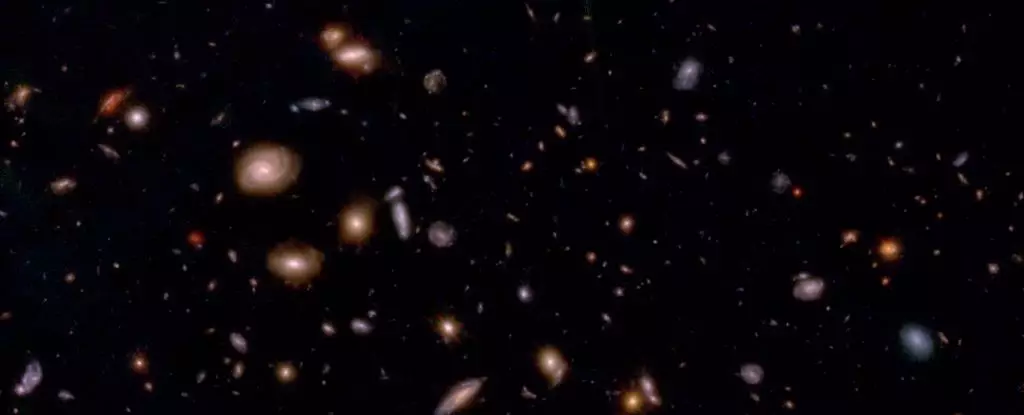When gazing into the vast expanse of the cosmos, one might expect to observe a random scattering of galaxies twirling through space, each with its own spin. However, new findings challenge this assumption, revealing a surprising uniformity in galactic rotation. Research led by astronomer Lior Shamir indicates that galaxies are not merely drifting randomly; they appear to be coordinated, with a remarkable majority spinning in the same direction. This phenomenon raises profound questions about our understanding of the universe and its fundamental laws. The implications are as intriguing as they are bewildering.
The Traditional View vs. The Unraveling Mystery
Historically, prevailing models of the universe have held that cosmic structures, such as galaxies, should exhibit a random assortment of spins — some clockwise, some counterclockwise — leading to an evenly balanced distribution. Yet, Shamir’s extensive research suggests a preference: among a selection of 263 galaxies observed through data captured by the James Webb Space Telescope, a distinct majority were found to be rotating in one direction. This observation starkly contrasts with the cosmological principle, which posits that the universe is isotropic and homogeneous on a grand scale. What could account for the unexpected synchronicity in rotation?
There are two leading theories. The first posits that the universe was born with an intrinsic rotation, a perspective that aligns with radical viewpoints such as black hole cosmology, which proposes that the cosmos may exist within the confines of a colossal black hole. The implications of this hypothesis reshape our understanding of space-time and challenge long-held beliefs about the universe’s birth and evolution, suggesting our theories might be fundamentally flawed or incomplete.
The Illusion of Galactic Rotation
In contrast, the second explanation offers a more mundane interpretation: the observed rotational patterns might stem from an optical illusion created by our unique vantage point in the Milky Way. While it is tempting to attribute the cosmic structure to random processes, it’s critical to consider the gravitational influence of our own galaxy on what we observe. This could mean that the rotation of the Milky Way impacts how we perceive distant galaxies, distorting the apparent symmetry of the universe. As mundane as this may sound, it speaks to the complexities of observational cosmology and the careful calibration required in our measurements.
Observations and Statistical Significance
Shamir utilized an array of quantitative analyses to examine the shapes of the sampled galaxies, and the results were stark. Of the 263 galaxies studied, 158 rotated clockwise, while only 105 exhibited a counterclockwise motion. This asymmetric distribution is not merely a statistical fluke; it represents a significant deviation from what astrophysicists would expect if the universe’s structures were genuinely random. This striking disparity invites scientists to question whether our existing models regarding cosmic evolution and formation need to be re-evaluated in light of these findings.
More intriguing is the assertion that the disparity becomes pronounced at greater distances, suggesting not only a historical bias in galactic rotation but also a potential framework for understanding the universe’s growth. If earlier galaxies exhibited this pronounced asymmetry, it might hint at underlying forces or conditions that acted upon them during the formative years of cosmic development.
The Power of Observational Tools
The advent of powerful observational tools like the James Webb Space Telescope marks a turning point in our exploration of the universe. These advanced instruments allow researchers like Shamir to peer deeper into cosmic history than ever before. He poignantly noted, “With the power of the James Webb Space Telescope, anyone can see it,” indicating that the pronounced difference in rotation is not merely a product of intricate calculations, but an observable fact for anyone with access to the right data.
This democratization of astrophysics through detailed imagery raises further questions about the future of cosmological research. Will new observations lead us to refine our current models, or will they steer us toward groundbreaking theories that reshape our conception of the universe itself?
Looking Ahead: Implications for Cosmology
The implications of Shamir’s findings extend beyond mere observation; they signal a potential shift in our understanding of cosmic mechanics. With theories suggesting the universe’s birth and formative processes might be influenced by rotational properties, researchers must now grapple with the effects of these discoveries on existing frameworks of cosmic evolution.
Beyond understanding galactic spin, such insights could methodically address other cosmological puzzles, like the rate of universal expansion. As we venture deeper into the cosmos and enhance our observational prowess, we may uncover layers of complexity previously unimagined, driving humanity to reassemble the pieces of the grand cosmic puzzle in unexpected and exciting ways. Welcome to the new frontier of astrophysics, where every mystery unlocked brings forth another set of questions that could redefine our place in the universe.


Leave a Reply